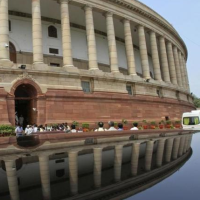GST in Sight, But Rajya Sabha Hurdle Remains
 The bill also needs the approval of more than half of India's 29 states (file photo: Reuters)
The bill also needs the approval of more than half of India's 29 states (file photo: Reuters)
The goods and services tax (GST), which was first proposed in 2006, took one step closer to reality on Wednesday, when the Lok Sabha passed a bill to replace a patchwork of levies by the central and state governments with a single nationwide sales tax.
A major reform proposed by Prime Minister Narendra Modi, the GST would subsume excise, service tax, state VAT, entry tax, octroi and other state levies.
This tax reform has been hailed by Finance Minister Arun Jaitley as the biggest in India since independence in 1947. He has said it could add up to 2 percentage points to the growth of the economy.
"The whole country, which is one-sixth of the world's population, would become a single market, and, therefore, it would give a necessary fillip as far as trade is concerned," Jaitley told MPs in the Lok Sabha.
According to Reuters, approval in the lower house marks an important victory for the government, but the bill still has to pass the Rajya Sabha where the NDA does not have a majority.
The Congress party supports the measure, but it boycotted the vote in the Lok Sabha, demanding that the bill be first reviewed by a parliamentary panel.
Further complicating matters are the competing interests of the central and state governments, which want to protect their tax revenue and retain fiscal control. The bill also needs the approval of more than a half of India's 29 states to be implemented.
The battle has already led to several compromises on the bill, leading some analysts to warn that India could end up being saddled with a badly designed tax.
A government think-tank proposed the tax rate be set at 27 percent, for example, which is well above the global average of 16.4 percent for similar taxes.
On Wednesday, Jaitley told lawmakers that the proposed rate was "too high" and needed to be "much more diluted". But some states are asking for an even higher rate.
Exemptions and exceptions have also been worked into the bill. The tax does not apply to alcohol, for example, and petroleum products will be taxed separately at first.
Manufacturing states will be allowed to levy an additional tax of 1 percent on supply of goods.
"All this would make Indian manufacturers and service providers uncompetitive," Saloni Roy, senior director, tax consultants Deloitte, told Reuters. "We need a GST that would widen the tax base and encourage tax compliance."
While the International Monetary Fund (IMF) said that GST would improve tax compliance and enhance economic growth it found the proposed structure too complex.
“The GST design being contemplated is... fairly complex, with a dual administration arrangement that involves the tax authorities of both the Centre and states separately taxing a single transaction,” said an IMF report on India.
Thomas Richardson, a senior resident representative of IMF in India and an author of this report, told the Business Standard that the central government would have to coordinate with 30 states under the proposed GST structure. It would also be administratively challenging because state tax officials did not have any experience in taxing services.
The GST is scheduled to be rolled out from April 1, 2016.
- Karan Singh
To Learn More:
India closer to biggest tax reform in decades (by Rajesh Kumar Singh, Reuters)
Lok Sabha approves GST Bill, paves way for uniform tax regime (PTI)
India's GST structure is complex, says IMF (Business Standard)
- Top Stories
- Controversies
- Where is the Money Going?
- India and the World
- Appointments and Resignations
- Unusual News
- Latest News
- India College Chain’s Expansion into U.S. Draws Opposition from Massachusetts Officials over Quality of Education
- Milk Shortages in India Tied to Release of New Movies Featuring Nation’s Favorite Stars
- Confusion Swirls around Kashmir Newspaper Ban in Wake of Violent Street Protests
- Polio-Free for 5 Years, India Launches Vaccine Drive after Polio Strain Discovery
- New Aviation Policy Could Increase Service, Lower Ticket Prices






Comments